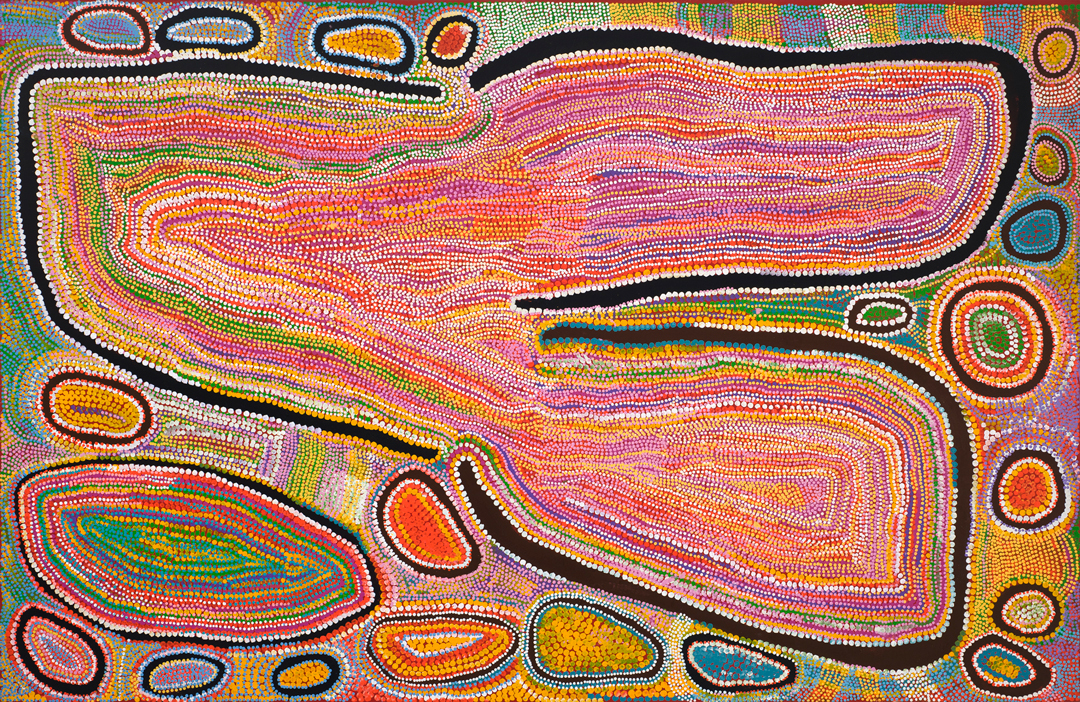Object of the Week: Wilkinkarra
The year 2016 wasn’t all bad, and in fact it proved a remarkable year for the growth of SAM’s permanent collection. Just in the area of paintings, the museum acquired Robert Colescott’s colorful Les Demoiselles d’Alabama: Vestidas, on view on the third floor at the top of the elevators; the beautiful Nicolas Colombel Cupid and Psyche now installed in the large European art gallery on the fourth floor; and quite a few other cool things. The largest painting SAM acquired, and among the most visually striking, is Wilkinkarra, a blast of spotted color spread over a 6-by-10-foot canvas, from Australian Aboriginal woman artist Mitjili Napanangka Gibson.
Wilkinkarra came to SAM from the distinguished collection of Margaret Levi and Robert Kaplan, out of which a whole survey of Australian Aboriginal art was culled. Ancestral Modern: Australian Aboriginal Art came to SAM in 2012 and showcased more than 100 artworks that, for many of us, provided an introduction to the history and thriving culture of Australian Aboriginal painting.
When encountering something new, we often try to connect it to something we already know and understand. This is natural because our brains are wired to make sense of new experiences and stimuli by comparing them to ones that already exist in our mental databank. Looking at Wilkinkarra, I was struck by how the aesthetic is distinctively “modern.” Countless bright pops of bold color—pinks, purples, blues, yellows, and oranges—emerge in organic patterns, encircled in heavy black outlines. The dotting approach echoes pointillist painting in the late 20th century, and we could also picture this piece fitting cleanly into newer schools of abstract art.
Only this is not an abstraction, but a representation of a specific landscape, pictured from a bird’s-eye view, and created within a unique culture and school of art-making. While we might see immediate, purely visual connections to the Modern art that we already know, there are still more meaningful connections to be made.
In the exhibition catalogue for Ancestral Modern, Lisa Graziose Corrin finds one of those connections in the idea of journeying. First, note that the features of the land itself, and the idea of moving through the land, have special meaning in Aboriginal culture: “Mitjili Napanangka Gibson’s Wilkinkarra refers to a ritual walkabout in her homeland. For Aboriginal artists, travel through the landscape is spiritual, something performed as well as painted. The ritual walkabout and the represented walkabout are equally significant mappings of sacred cultural experience. Both ensure the continuation of Aboriginal cultural memory that is deeply embedded in the topography of ceremonial places.”¹
Second, consider Corrin’s idea that “At one level or another, contemporary culture is a traveling culture.” The city of Seattle plays host to crowds of neo-nomads. The actions of moving, traveling, journeying, and migrating affect many of us in profound ways, shaping how we understand ourselves and how we relate to the people and places we encounter. Global Modern and contemporary art reflects these ideas. At SAM we see it in works like Jacob Lawrence’s Migration Series, and in William Kentridge’s Shadow Procession. Lawrence, Kentridge, and now Gibson remind us that sharing about where we go, and what we go through, is a very human thing to do.
–Jeffrey Carlson, SAM Collections Coordinator
¹ Lisa Graziose Corrin, “Staging Australian Aboriginal Art,” Ancestral Modern: Australian Aboriginal Art, exhibition catalogue, Seattle: Seattle Art Museum, in association with Yale University Press, 2012; 46.
Image: Wilkinkarra, 2007, Mitjili Napanangka Gibson (Australian Aboriginal, Warlpiri people, Western Desert, Northern Territory, born ca. 1940), synthetic polymer paint on canvas, 78 3/4 x 120 1/16 in. Seattle Art Museum, Gift of Margaret Levi and Robert Kaplan, 2016.25.
